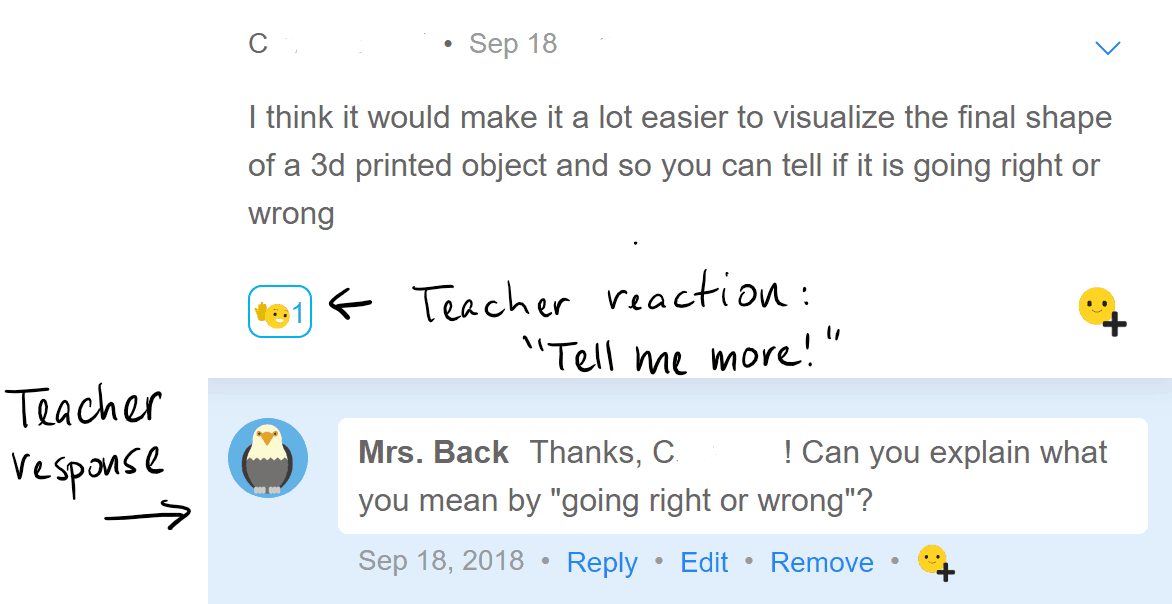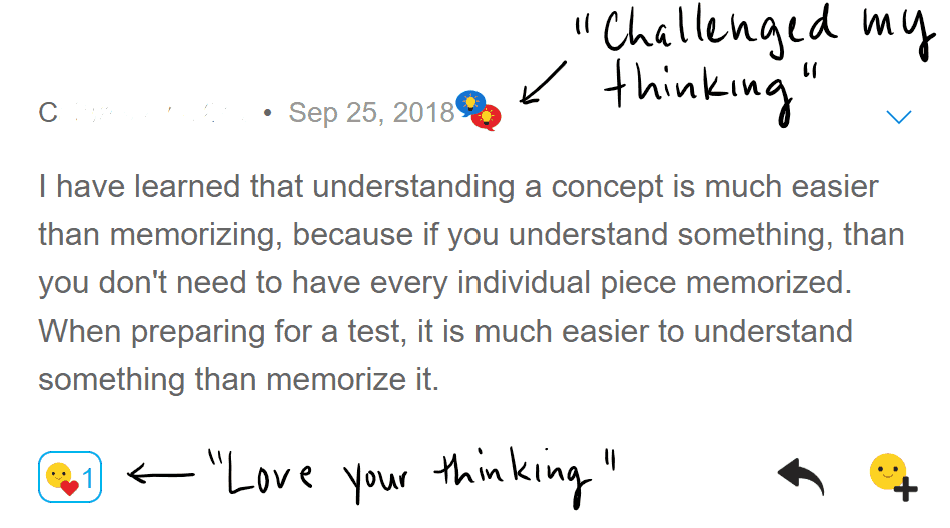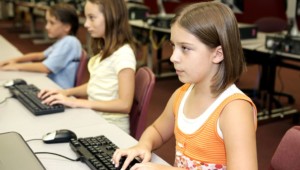Making the Most of Student Reflections

This past school year, I sought to ask my students to reflect upon their learning more often. These reflections have allowed me to get to know my students better, understand their strengths and weaknesses with content and study habits, and discern what kind of connections they are making between topics and disciplines. But the reflections had great benefits for my students, too. Over the course of the year, I saw them grow as they were asked to more frequently take time to self-assess what they knew or how they could improve their understanding.
Here, I share how I collect student reflections, when I ask students to reflect, how reflections benefit students, and how I use their reflections to inform my teaching.
How I Collect Student Reflections
I ask students to reflect in whatever medium makes sense for the topic. Therefore, some reflections are made on paper and some are online. My favorite online or digital tools are:
- GrokSpot: GrokSpot is an easy-to-use collaborative discussion tool for a classroom that blends reflection with mindset messages. Students and teachers can reply to reflections with both words and mindset-based emoji.
- Microsoft OneNote: OneNote is a powerful digital notebook for teacher and student interaction. Students using Class Notebooks can respond to reflection questions by typing text, inserting pictures or video, or writing/drawing with a smart pen and digital ink. Teachers can easily provide feedback on student responses using text or digital ink.
- Online Forms: Teachers create a form in Microsoft Forms or Google Forms. Student responses are recapped online and collected in a spreadsheet for easy analysis.
Other online platforms that could be used for reflections include:
- Video Discussion Tools, such as Flipgrid
- Shared Documents, such as Google Docs or Office 365
- Group Collaboration/Chat Software, such as Microsoft Teams or Slack
- Various formative assessment tools
When I Ask My Students to Reflect
- At the Beginning/End of Year: I start each year with a discussion about mindset and the “Power of Yet” . My students fill out an online form that asks them reflection questions such as: What are you looking forward to in this class? What are you most apprehensive about in this class? How do you feel when you make a mistake in math? How do you feel when you are facing a challenging problem in math? I keep specific responses private, so I create word clouds like the ones below to engage the class in a discussion about their mindset.


At the end of the year, I ask students for a final reflection. This year, I asked the following question in GrokSpot:

I was impressed by the thoughtfulness and honesty of student responses, which I shared in a recent post about inspiring serendipity in the classroom.
- During Learning: As students are learning new concepts, I ask them reflection questions during class or for homework. Questions vary and include: What is one topic from this section that you understand well enough to teach to a classmate? What has been the least (or most) challenging topic for you in this section? What did you learn about this topic that surprised you?
In the image below, I show a student response to a question I asked in GrokSpot: “Why do you think it is important to be able to identify the shape of a cross-section when designing an object for 3D printing?” When responding to this student, I choose the mindset emoji “tell me more” and followed up with a comment that asked the student to explain further.

I also ask reflection questions about the process of learning, such as this question that I posed in GrokSpot: “In class, we’ve been talking about the difference between understanding concepts versus memorizing. Has this changed the way you have learned anything this year?” The student who wrote the response shown below chose the mindset emoji for “challenged my thinking.” I responded with the “love your thinking” emoji.

- After Assessments: I allow students to correct their mistakes on assessments after they respond to a few of the following reflection questions on paper or in Microsoft OneNote: What study strategies worked best for you when preparing for the assessment? What did you like most (or least) about this test? If you were not happy with your score, what would you do differently next time? Do you feel that making corrections to the assessment helped you to learn from your mistakes?
I have been amazed at the honesty and detail in students responses. I write at least one short, positive, and encouraging response to acknowledge their thinking, as shown in the example below. If a student response is vague, I suggest a study strategy for them to try next time.

- Connections in the Community: After my students visited our school art show, I used GrokSpot to ask, “What are some math connections that you noticed or wondered about during your visit to the art show?” In the response below, the student selected the “grew my thinking” emoji, and a classmate replied with the “pondering” emoji.

How Reflections Benefit Students
Too often, I see students manage their time by jumping from one due date to the next, learning exactly what they think they need to know for the upcoming assessment, homework assignment, or project. Some students simply don’t make time to think about the topics they have learned and how well they understand until the night before a quiz or test, when it is too late. Asking students to reflect on one class or one idea forces them to make time to determine if they understand before it is too late to seek help. In addition, the process of collecting, organizing, and communicating their thoughts to another person can help a student realize that they don’t fully understand a topic or idea. As many teachers can attest, you don’t really know a topic thoroughly until you have to teach it (or communicate it!) to someone else.
Reflections also give students a chance to practice making and acting upon growth mindset comments. I worked with one particular student a few years ago who wanted to improve his quiz and test scores. In each post-assessment reflection, he honestly explained how he studied. I responded with other strategies for him to try, including meeting with me to go over questions and making his own practice tests. He tried every strategy I suggested, and about halfway through the year, earned close to a perfect score on a test. In his reflection, he proudly stated that by trying new study strategies, he finally learned how to determine when he really understood the material. His hard work and growth mindset paid off!
Finally, reflections help students find connections with other classes or in their community that they may not have noticed otherwise. By looking for evidence of math in the student art show, students realized that math is around them in places they never expected. The reflection forced them to grow their thinking and look at the world through the lens of a mathematician.
How I Use Student Reflections
Student reflections have been a treasure trove of information that informs my planning for future lessons, helps me decide upon strategies to review material, and enables me to see which connections students make between math and other disciplines. For example:
- When I notice trends in the reflections of one student, I can determine how to intervene to better support the student’s learning and have detailed conversations with either the student or the parent.
- Sometimes, students don’t follow their own reflection advice when preparing for the next assessment. Because of this, I am working on interweaving the teaching of study strategies into my classes and reminding students to look back at their reflections when studying.

- GrokSpot enables me to ask students to gauge their confidence level, which is seen only by me. This has enabled me to help students determine why their performance on an assessment differed from their perceived confidence level. An example of a confidence indicator is shown at right.
- When writing report card comments or letters of recommendation, I sometimes include quotes from student reflections to show evidence of growth.
It took time to adjust my classroom routine to make time for these reflections. I preferred to assign reflections as the only homework assignment, but asking for reflections at the start or end of class also provided fruitful responses.
Where can you learn more about student reflections? Some of my favorite resources include the following: Mathematical Mindsets, Teach Students How to Learn, Make it Stick: The Science of Successful Learning, and various articles about assessment for learning.
For more, see:
- The Student Role in Formative Assessment: How I Know Practitioner Guide
- Creating Change-Agents: The Intersection of Critical Thinking and Student Agency
- Using Student Feedback to (Actually) Drive Change
All pictures in this post were created by Jamie Back.
Jamie Back is an Upper School Math Teacher at Cincinnati Country Day School. Follow Jamie on Twitter: @jmeb96
Stay in-the-know with innovations in learning by signing up for the weekly Smart Update.





0 Comments
Leave a Comment
Your email address will not be published. All fields are required.